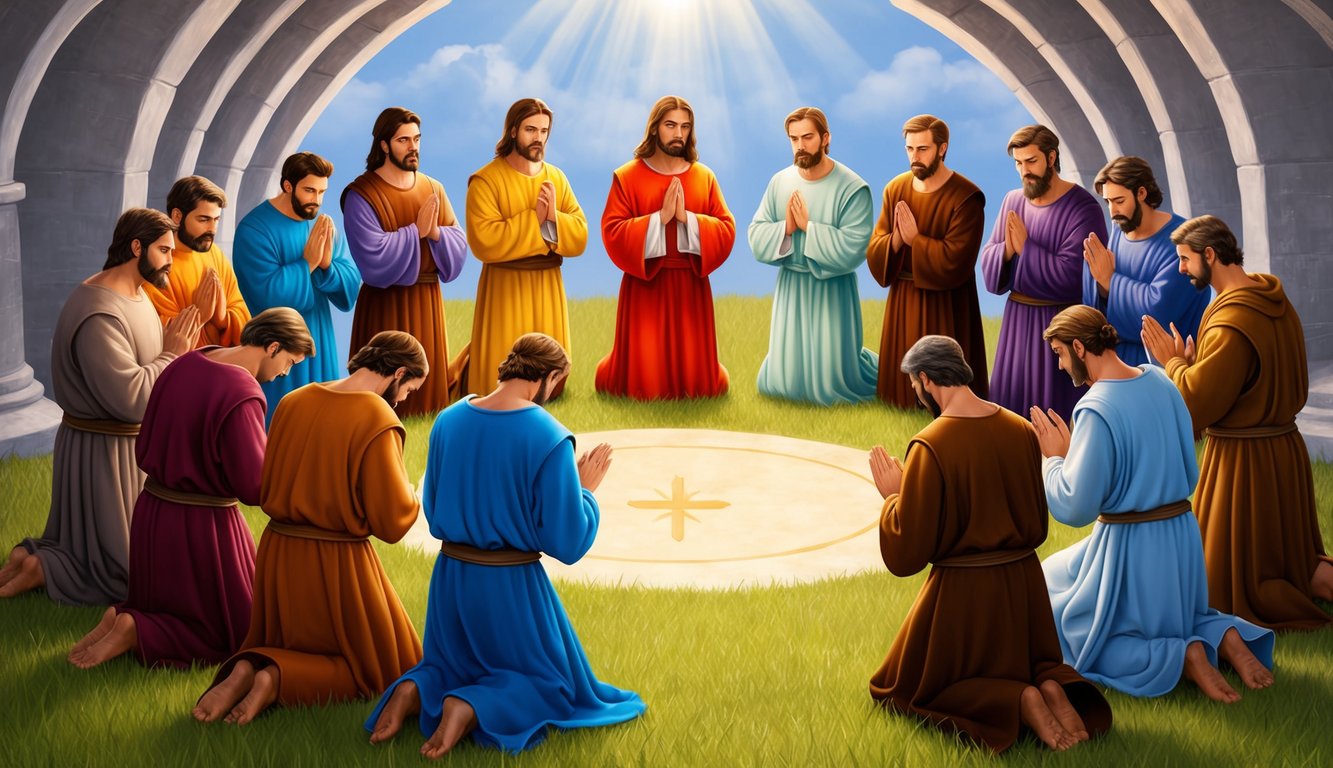Don’t Miss Out On This Unique Astrological Opportunity
Are you tired of spinning your wheels and getting nowhere? Simply put, you’re out of sync: you’re out of alignment with your astral configuration.
But: there’s a kind of map that can help you reclaim your alignment. Think of it as your own personal blueprint to success and happiness: a blueprint that will help you live your most amazing life.
Get started here.
When you think about the foundations of Christianity, the 12 disciples of Jesus Christ come to mind as key figures.
These men, chosen from a larger group of followers, played a crucial role in spreading his teachings and establishing the early church.
As you explore their lives, you’ll find diverse backgrounds and personalities.
From fishermen to tax collectors, the disciples brought various skills and experiences to their mission.
Their journeys were filled with moments of doubt and faith, making them relatable figures for believers.
By understanding their stories, you get a glimpse into the early days of the faith as described in the New Testament.
As you dive deeper into their lives, you discover how they paved the way for future Christians.
Their travels and teachings played a direct role in spreading Jesus’s message worldwide.
How did they overcome challenges and stay committed to their cause? With their profound influence, the lives of the 12 disciples continue to inspire believers today.
The Calling of the 12 Disciples
In the Bible, Jesus called twelve individuals to become His closest followers, known as disciples.
This group was significant as they played critical roles in teaching and spreading Jesus’ message across regions like Galilee and Jerusalem.
First Disciples and Their Backgrounds
The first disciples Jesus called came from varied backgrounds.
Many were fishermen, including Peter, Andrew, James, and John, who were called from their boats along the Sea of Galilee.
Being fishermen, these early followers were familiar with hard work and dedication.
You might find it interesting that Matthew was a tax collector, which was an unpopular profession at that time.
This choice illustrated the range of individuals Jesus selected, highlighting that anyone, regardless of background, could be called to serve a higher purpose.
As you explore the narratives, check out the story of John’s Gospel, where two followers of John the Baptist became part of this core group.
By drawing from diverse life experiences, Jesus brought together a team that could reach and teach different communities effectively.
Symbolism in the Selection
The choice of twelve disciples was symbolic and intentional, reflecting the twelve tribes of Israel.
Jesus’ selection and naming of the twelve also served as a new beginning, an era where His teachings would reach far and wide.
The number twelve resonates with a sense of completeness and governance.
You might wonder why symbolism was so critical.
It showed continuity with past traditions and the establishment of a new covenant through Jesus’ ministry, as seen in biblical texts like the Acts of the Apostles.
This union of old and new served as a powerful reminder of Jesus’ mission to restore and renew faith beyond Jerusalem.
Roles and Characteristics
In learning about the 12 disciples, you’ll discover their unique contributions and traits.
Each played a role that shaped early Christianity and influenced the spread of its teachings.
This section explores some of the most important figures among the disciples.
Peter as the ‘Rock’
Peter is often seen as the leader among the disciples.
Jesus named him Peter, meaning “rock,” to symbolize his foundational role in the church.
You can read about Peter’s leadership in the Gospel of Mark.
Known for his strong faith, Peter was also known to falter at times, such as when he denied Jesus three times before the crucifixion.
Despite his flaws, Peter played a crucial part in the early Christian church.
He preached at Pentecost, where many people were converted.
His bold actions and speeches continued to inspire and guide the early believers, cementing his legacy as a pillar of faith.
James and John – ‘Sons of Thunder’
James and John, brothers in the group, were given the nickname “Sons of Thunder.” This reflected their fiery enthusiasm and passionate nature.
Known for their close relationship with Jesus, they were part of the “Inner Circle” along with Peter.
This group witnessed key moments like the Transfiguration.
Their lively personalities sometimes led to tension.
For instance, they once asked Jesus if they could sit at his right and left in his kingdom.
Despite these ambitions, their loyalty never wavered.
After Jesus’s death, James became the first martyred apostle, while John continued writing and spreading the message, contributing to the Gospel of John.
Matthew – The Tax Collector Turned Apostle
Matthew was initially a tax collector, a role often frowned upon in society.
His inclusion in the disciples shows Jesus’s openness to all, regardless of past.
Converting from his previous life, Matthew became a passionate follower.
His unique perspective enriched the group and later influenced the Gospel of Matthew.
Matthew’s experiences lent him a distinctive voice and viewpoint on Jesus’s teachings.
They offered a deep empathy for outcasts and a keen focus on fulfilling prophecies.
His transformation illustrates the power of faith to change lives and bring people into the fold of Christian teachings.
Judas Iscariot – The Betrayer
Judas Iscariot is known for betraying Jesus, a pivotal event leading to the crucifixion.
As treasurer for the disciples, Judas was in charge of their funds, but his actions revealed a darker side.
His betrayal for 30 pieces of silver is one of the most infamous moments in the Bible.
Understanding Judas’s role challenges you to think about loyalty and repentance.
While his actions set off a chain of events crucial to Christian doctrine, they also serve as a reminder of human frailty.
Despite his betrayal, Judas remains a complex figure whose choices had far-reaching consequences.
The Apostles’ Journeys

The apostles traveled far and wide to spread the message of Christianity.
Their journeys were filled with remarkable feats and significant hardships.
Here, you’ll discover how they shared the gospel and faced dangers along the way.
Spreading the Gospel Across Nations
The apostles set out to preach the teachings of Jesus throughout many lands.
Their mission was clear: to reach as many people as possible.
Paul is often noted for his extensive travels.
He ventured to places like Ephesus and eventually to Rome, working hard to establish the early church across these regions.
Thomas was said to have journeyed to India, sharing the gospel there.
Through their Ministry, they laid down the foundation for Christian communities by baptizing believers and appointing leaders in different areas.
They were sometimes accompanied by companions who helped in their mission, establishing a network of early followers.
Challenges and Martyrdom
Journeying to spread Christianity was not without its challenges.
The apostles often faced opposition and dangerous situations.
Peter and John preached boldly in Jerusalem, despite threats and imprisonment.
Their unwavering dedication was crucial in establishing the early church there.
Many apostles met difficult ends.
For instance, James, the son of Zebedee, was martyred in Jerusalem.
Others, like John, faced exile.
He was banished to the island of Patmos, where he is believed to have written the Book of Revelation.
These challenges did not deter them, emphasizing their profound commitment to their faith and mission.
Life After Jesus’s Ascension

When Jesus ascended to heaven, it marked a significant transformation for His disciples.
They became leaders, spreading Jesus’s teachings and establishing the foundation of the early Christian Church.
These early Christians faced challenges and vital decisions as they began this new chapter.
Formation of Early Christian Communities
After Jesus’s resurrection and ascension, the disciples were pivotal in forming the first Christian communities, known as the Early Church.
They stayed in Jerusalem, gathering in homes to pray and share teachings.
They were soon empowered by the Holy Spirit during Pentecost, sparking their mission.
You might find it interesting that this event, described in the Book of Acts, marks the start of their active mission work, spreading the Gospel message.
This was done through sermons, baptisms, and establishing new churches, which helped Christianity grow beyond Jewish communities.
Adding Matthias to the Twelve
One of the first major tasks for the apostles was replacing Judas Iscariot to restore their number to twelve.
In a significant event for the Early Church, they chose Matthias through a process involving prayer and casting lots, as highlighted in various biblical texts including the Acts.
This decision was crucial because the apostles believed that having twelve members reflected the twelve tribes of Israel.
Matthias’s addition signaled a fresh start, and he became an integral part of spreading Jesus’s teachings, ensuring the continuity and growth of the Early Church.
Literary Contributions and Legacies

You will find that the twelve disciples played crucial roles in shaping early Christian texts.
They contributed to the formation of the New Testament and influenced later religious thinkers.
This section focuses on the Synoptic Gospels and Acts, highlighting their significance alongside the lasting impact on church fathers.
Their teachings and experiences helped develop key theological concepts that remain foundational to Christian doctrine.
In particular, Mark 11 insights offer valuable perspectives on faith, prayer, and Jesus’ authority, which are frequently referenced in theological discussions.
The disciples’ contributions ultimately shaped not only scripture but also the broader Christian tradition.
The Synoptic Gospels and Acts
The Synoptic Gospels—Matthew, Mark, and Luke—are central to understanding the teachings of the twelve disciples.
These texts present the life and teachings of Jesus from different perspectives.
Each Gospel provides unique insights, making them essential for early Christian communities.
In Matthew, the teachings emphasize Jesus’ role as the Messiah.
Mark gives a more action-oriented account, focusing on Jesus’ miracles and passion.
Meanwhile, Luke is known for its emphasis on compassion and the inclusion of marginalized groups.
Acts, attributed to Luke, continues the story of Jesus’ followers.
It outlines the establishment of the early Church, detailing the apostles’ efforts to spread the message.
The text highlights the pivotal roles of Peter and the Apostle Paul, illustrating the transition from a Judaic context to a broader Christian mission.
The Influence on Later Church Fathers
The disciples’ influence extended beyond the Gospels.
Later church fathers like Justin Martyr and Origen found their teachings foundational.
These thinkers studied the accounts of the apostles and used them to shape Christian doctrine.
Justin Martyr was a disciple of earlier theologians.
He wrote extensively on the teachings of the apostles.
His works highlight the philosophical underpinnings of Christian beliefs.
Origen, another prominent figure, was also significantly influenced by the apostolic writings.
The Gospel of John and the Revelation also impacted these later figures, offering mystical insights into Christian theology.
Through their reflections and interpretations, the legacy of the twelve continued to inspire diverse theological explorations within Christianity.



